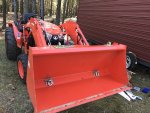I am a tractor newbie so take this for what it is worth, but my understanding is that it is best to avoid placing heavy loads on the FEL when the bucket is in the fully dumped/rolled position as the hydraulic cylinders are fully extended and at greatest risk of damage. Maybe I am off base on this but just floating the thought for consideration.
Like Henro said, if you back drag, you are putting collapsing forces on the bucket curl cylinders (i.e. trying to roll the bucket up) against the unvented rod end. Hydraulic oil does not compress, and will be just as hard as steel when this happens. The bucket/SSQA pivot is a fairly long moment arm at a really severe angle at the cylinder rod knuckle when tilted forward and can create tremendous forces in the wrong directions. The mechanics of the bucket cylinders are designed to withstand the forces in a pulling mode, not pushing. In retracting (pulling) mode, a cylinder will typically develop only about half the amount of force as it will extending, depending on cylinder bore and rod diameter. E.G., you have 4 square inch bore cylinder with a rod that's 2 square inches, the force in the push direction (pressure at head end) is 4 x Pressure. In the retract mode, it's (4-2) x pressure, half as much. Length of stroke has very little to do with it, except in hybrid cylinders. The cylinder rod cross sectional area is subtracted from the the bore cross sectional area when pulling. This is why the mounts for the bucket cylinders are typically relatively small perches or even on cross members as compared with the mounts for the boom cylinders. With the bucket fully forward, the cylinders are also fully extended, making them prone to even the slightest radial force at the rod seal. Fully extended is simply not the best operating position for a cylinder for any reason. When I'm lifting with the bucket rolled forward, I'm not using the bucket cylinders at all. In fact, I'm intentionally avoiding most of the loading on the cylinders by letting my chain hang straight down from the d-rings. If I roll the bucket up, then yes, it's going to put some force on the cutting edge of the bucket with the chain, but remember, I'm pulling with those cylinders, not pushing. I'll hurt the bucket or SSQA before I hurt the cylinders. Again, the bucket curl cylinders will just simply stall (with a lot less force) if the pressure cannot retract the cylinders. When raising the load, all the force is supplied by the boom cylinders with that rigging, which are operating in push mode, or pressure at the head end, using the entire cross section of the bore.
Most modern tractors have a float function, though. This vents the head end to the rod end on the boom cylinder netting zero force in either direction and letting the boom effectively float with no up or down force on it other than gravity. This is very handy for back-dragging or skimming.
Overloading or improper rigging with the center of gravity forward of the bucket pivot pins or not in line with the centerline of the tractor (ergo the loader) it is entirely possible to twist the boom. There are two boom cylinders, so it's a good idea to use both of them by keeping the load between them. The boom can be overloaded while lifting, but typically it will just stall (pressure relief) and not lift the load any farther when the pressure relief on the pump bypasses. If it doesn't relieve (someone shimmed the pressure regulator too much, or the relief valve is stuck in an older machine), there is a possiblity of lifting too far out beyond the front wheels (especially with forks) exceeding the load rating of the boom, which will likely cause it to overcome ballast on the rear, and risk tipping the tractor because the front axel pivots at the center where the rear one does not. Cow tipping fun. Tractor tipping NOT. THAT is why rear ballast is very important when using the FEL. Keep the back feet on the ground, and get the load as close to the ground as it can be as soon as possible. Rule #1 of ANY lifting operation. Worst case, a line could rupture, and a catastrophic fall is going to happen.
Just be mindful of the limits of the equipment. I'm going through that mental exercise right now in anticipation of purchasing a heavy piece of equipment (chipper) that will have to be unloaded. I will know for certain that I can lift it with my loader before I have it delivered, or I'll have to result to different logistics. Center the weight as best possible with the tractor, and keep it as close as possible to the front wheels, and you should be OK if you have sufficient ballast. My oversized R14's are glycol filled, and I intend to hitch up my box blade to add that little bit more. Might even stack some blocks on the box blade for even more insurance. I've stalled the bucket and the boom several times trying to scratch stumps out of the ground, so I already know the boom will not lift the back of the tractor from ground level. That's a completely different story from lifting a load off a freight trailer, though.
There are plenty great videos about FEL use. That's one of the ways I've learned a lot about my little orange buddy, and then a lot of experimentation with very gentle movements.



